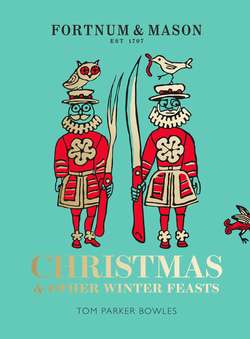Читать книгу Fortnum & Mason: Christmas & Other Winter Feasts - Tom Bowles Parker - Страница 10
Fireworks and Papist plots
ОглавлениеAh, Bonfire Night. The dazzling fireworks, burnished sausages, steaming paper cups of searing mulled wine. Children, crazed by cola, their eyes agleam with sugar and glee, their spirits as high as those rockets above. All centred on that roaring, crackling inferno, spilling warm light into the inky black gloom. So it seems a little incongruous that this merry night commemorates not the start of winter, nor some pagan feast, but rather the ritualised burning of a Papist plotter.
Which is, of course, the very reason for its existence – a celebration of the death of Guy Fawkes, who, along with his fellow conspirators, had planned to blow up King James I and the whole House of Lords.
Gunpowder Treason Day, as it was originally known, was actually a mandatory day of celebration, enforced by the introduction of the Observance of 5th November Act. But as ever in matters of the Protestant church, it quickly became a focal point for anti-Catholic abuse. While Puritans ranted and raved about the perils of popery, the common folk saw it as a time to rejoice, inspired more by the spirit of gin than that of the Lord. And, like the Christmases of old, festivities became increasingly drunken and raucous, with effigies of popular hate figures being burnt, including the Pope himself.
As time moved on, children would go begging with effigies of Guy Fawkes, a strictly seasonal money-making opportunity. Hence ‘a penny for the guy’. And so the 5th of November transformed into Guy Fawkes Night. By the nineteenth century, things were getting a little more violent, with confrontations mired in class hatred. ‘A chance,’ according to an 1850 article in Punch, ‘for the lower classes … to pit disorder against order, a pretext for violence and uncontrolled revelry.’ In Lewes, there was ‘lower class rioting’, and the intimidation of ‘respectable householders’, while in Guildford, ‘gangs of revellers who called themselves “guys” terrorised the local population’. Lewes still sets alight an effigy of Pope Paul V, an act of remembrance for the town’s seventeen Protestants burned at the stake during the sixteenth century. During this ‘close to the knuckle’ celebration, they also incinerate various villains du jour.
But for the rest of us, it’s the chance to wrap up warm, pray that the rain will hold off, and stare for hours into the flaming pyre. And at this chill, dark time of year, the sort of hearty, belly-sticking tucker that Fortnum’s sent out with intrepid climbers and explorers is exactly the sort of food one craves. Rich venison sausages, jacket potatoes stuffed with all manner of delights, and a very Fortnum’s take on the Cornish pasty … where the steak is replaced by game. ‘Fun food’, in the words of Hugh Ruttledge, that great Everest explorer, to lift the spirits and soothe the soul. Bonfire Night may have its roots in attempted regicide. But these days, it’s more about feasting. With a bang.
